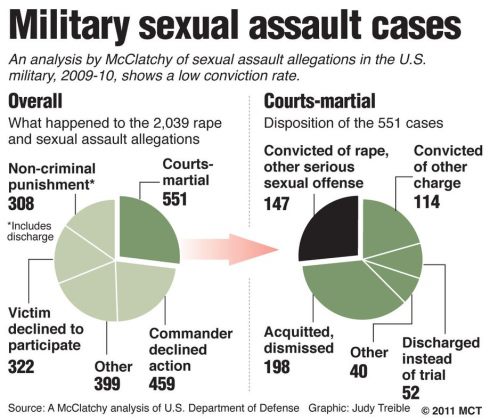Militarization of Rape in American Society
Sexual harassment, assault, and rape are topics that are very difficult to discuss. American society has taken strides to develop programs, protocols, and legal actions to help victims of these heinous crimes. Despite these efforts, there are still environments where women and men experience this act of violence at disproportionately high rates. In the newly released documentary, The Invisible War, we are exposed to the high incidence of rape in the United States military.
The documentary opens up with a caption that reads: “All statistics are taken from government studies.” The main subjects of the film are a group of individuals who were victims; all were raped while serving in the military. The film makes a remarkable contribution by pinpointing the loopholes in the military’s prosecution system, while making viewers aware of how serious rape in the military is, and how thousands have been able to get away with committing this crime.
According to government statistics, there was a reported 2,039 rape allegations during 2009 and 2010. This number is not representative of the total cases: There could be hundreds, or even thousands more women and men who did not report incidents. Of those 2,039 rape allegations only 147 resulted in rape or serious sexual assault convictions.
So what happened to the 1892 other allegations? Please refer to the breakdown taken from the documentaries’ website, notinvisible.org.
When I saw these statistics, I couldn’t believe the number of cases that get dismissed or funneled into different types of actions.
Other than providing statistical evidence of rape in the military, the film comments on power and masculinity in American society. According to one of the victims, Kori Cioca, she was the only woman among a group of 8 men while serving in the Coast Guard. In a recent interview on national television, Cicoca said that she thinks her supervising officer raped her for “power,” claiming “he hated her and spit on her multiple times.” After Cioca was raped, she reported the incident to a superior, but nothing happened to her perpetrator. According to rape victims, they are often kicked out of the military, while the offender continues to serve with no consequences against their actions.
In all, the film gives awareness to the issue of rape in the military. I highly recommend the film, and feel it is ideal for any course focusing on gender in society.
Suggested Readings:
Lieberman, Rachel. 2011. “Lara Logan, agenda-setting, and the politics of sexual assault coverage in mainstream media. Sociology Lens.
Nuciari, Marina. 2006. “Women in the Military Sociological Arguments for Integration.” in Handbook of the Sociology of the Military. Eds. Giuseppe Caforio. Pp.279-299.
Riley, Robin. 2008. “Women and War: Militirism, Bodies, and Practice of Gender.” Sociology Compass. 2(4): 1192-1208.
Sadler, Anne, et al. 2003. “Factors Associated With Women’s Risk of Rape in the Military Environment.” American Journal of Industrial Medicine. 43:262-273.








The incidence of rape in the military is horrific, but it is seemingly condoned by the government. As Zimbardo’s Stanford Prison experiment showed, when there are no consequences for actions, people will often behave in out-of-control ways when there are no limits to what they can do. In order for there to be a safe and respectful society within the military, and really in society as a whole, there need to be specific punishments that are carried out every time a rape or sexual assault occurs. If the potential cost of behaving this way outweighs any potential benefit, whether that benefit be sexual gratification or a sense of holding power over another, then and only then will the crimes stop.